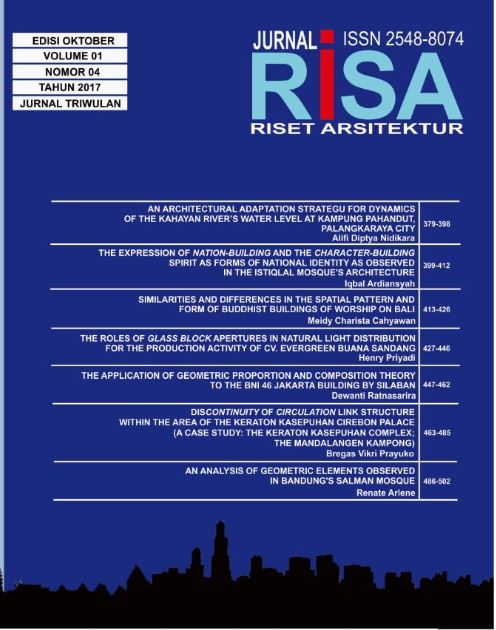SIMILARITIES AND DIFFERENCES IN THE SPATIAL PATTERN AND FORM OF BUDDHIST BUILDINGS OF WORSHIP ON BALI
DOI:
https://doi.org/10.26593/risa.v1i04.2758.413-426Abstrak
Abstract- In addition to Hinduism, Balinese people are familiar with Buddhism that entered the region at almost the same time as Hinduism during Dharmaudayana’s reign. Unfortunately, due to the large number of sects and religions developed at that time, there was religious simplification by Mpu Kuturan. Syncretism occurred between Shivaism, Buddhism (Mahayana), as well as original Balinese local religion merging into Shiva-Buddhism that developed into Balinese Hinduism that has been prominent until the present. After independence, the school of Buddhism that had not been influenced by the conditions and local denominations was resurrected and had Vihara temples built. Hence, the existence of Buddhist buildings of worship on the island of Bali from the IX-XI century called Candi (Vihara). Based on this phenomenon, the need arose for identifying similarities (in terms of continuity) and differences (discontinuity) of spatial and formal patterns in the Buddhist buildings of worship in Bali within the typo-morphological context, namely Goa Gajah (Elephant Cave), Candi Pegulingan (Pegulingan Temple), Candi Kalibukbuk (Kalibukbuk Temple), Brahma Vihara Arama (Brahma Arama Temple), and Vihara Buddha Sakyamuni(Buddha Sakyamuni Temple). The descriptive qualitative method was used through field observation of individual research objects which was subsequently identified and analyzed to discover the similarities and differences as well as mutual relations in accordance with variables determined by theoretical analysis concerning typo-morphology and Buddhist buildings of worship. There are similarities and differences in each research object. The similarities and differences exist due to the strong beliefs and closely guarded simbols of Buddhism although there is also the influence of local and traditional elements on the Balinese order of life. These, in turn caused the existence of numerous patterns of each object. The new patterns are the reflection of the various forms of assimilation that occur on Bali.
Keywords: Buildings of Worship, Candi, Vihara, Bali, Typo-morphology












